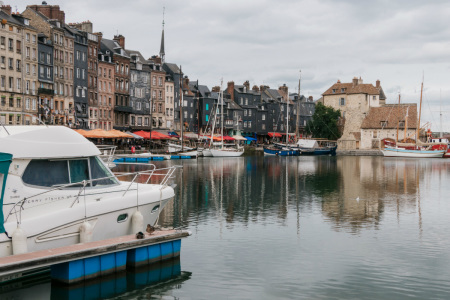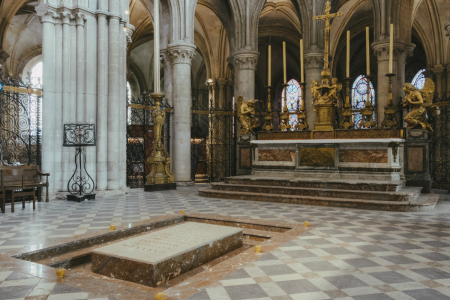History, spires and charm await in Normandy

Normandy may be best known for D-Day, though visitors to this region in France can discover much more than its seminal role in World War II.
In fact, part of its history is intertwined with America’s inherited history as it was the home of William the Conqueror.
The legacy of his 1066 conquest of England remains with us almost 954 years after the Anglo-Saxon king was killed on the battlefield at Hastings. Not only did the Normans influence the English language — numerous everyday words like beef and pork were borrowed from Norman French — but even something as simple as an inherited family surname was brought over with the Normans.
Normandy’s rich history, incredible medieval churches and charming towns can easily be discovered over the course of a five-night road trip.
Day one
The drive from Paris Charles de Gaulle Airport to Giverny takes a little more than an hour.

The big attraction is the house of Claude Monet, including the famous pond and water lilies that served as the subject of so many masterpieces. Don’t overlook the Church of St. Radegund. The interior includes a notable polychromed statue of St. Louis of Toulouse (also known as St. Louis of Anjou) from the 14th century.
Spend the night at the Hotel La Musardière, a charming 11-room hotel and restaurant that focuses on locally sourced ingredients. This also lets you experience Giverny after the day trippers leave for the next stop on the tour bus.

Day two
Following a morning walk through the village drive about 90 minutes to Honfleur.
The port town, once part of English-occupied France during the Hundred Years’ War, is located at the estuary where the Seine River meets the English Channel and was frequently painted by Impressionist artists.
The guided tours available through Honfleur’s tourist information office are valuable when visiting sights like the Church of St. Catherine.
The wooden church, built by shipbuilders in the mid-1400s after Honfleur was liberated from 51 years of English rule, was intended to temporarily replace a destroyed church until a more permanent stone church could be erected. Six centuries later, it remains. Besides being one of France’s oldest wooden churches, it is also notable for its double nave — the central interior mistakenly called a sanctuary by some churchgoers.
The Hotel L’Absinthe, housed in a 16th century harborfront building at the heart of old town, is highly recommended. For dinner, eat at the hotel’s own restaurant with its 400-selection wine list. Afterwards, embark upon a long, meandering walk.

Days three and four
The 1066 chapter of Normandy’s history comes into focus at the appropriately named Bayeux Museum in Bayeux.
Here is where you find the world-renowned Bayeux Tapestry, which despite its name is actually an embroidery of woolen thread on linen cloth. At 230 feet long, the object — essentially medieval propaganda — depicts a Norman narrative of the invasion and conquest of England through dozens of embroidered scenes. Perhaps most remarkable is the treasure’s very survival.
Nearby stands Bayeux Cathedral, where the tapestry was originally housed. It was consecrated in 1077 in the presence of William the Conqueror himself. The architecture, a blend of Romanesque, Gothic and later additions, includes an elaborate west front with five carved portals.
Twenty miles away in Caen is St. Stephen’s Abbey, a monumental Romanesque former monastery that contains William’s tomb. Sadly, the tomb has been destroyed and rebuilt over centuries of tumult, including during the French Revolution.
Forget about navigating streets in Bayeux’s city center with a rental car. The Novotel, a perfectly fine chain hotel, is within walking distance of the cathedral and museum.

Day five
No visit to Normandy is complete without going to Mont-Saint-Michel.
The breathtakingly beautiful rocky tidal island is situated just off the coast at Normandy’s border with neighboring region Brittany. Driving from Bayeux takes a little more than one-and-a-half hours.
Mont-Saint-Michel owes its existence to St. Aubert, the eighth century bishop of Avranches, who built the oratory dedicated to St. Michael the Archangel that eventually became an abbey. By the 11th century the number of pilgrims visiting was so great that the abbey was rebuilt into what you basically see today, though additions continued through the 15th century.
This religious foundation continued until revolutionary France and Emperor Napoleon, when Mont-Saint-Michel was converted into a prison. The prison closed just as historic preservation and modern tourism became popular in the late 1800s.
As with Giverny, most visitors come over the causeway linking it to the mainland only for the day. This makes spending the night a must.
Just be prepared to spend money as nothing is inexpensive, though the overnight experience at Hotel Les Terrasses Poulard is well worth the cost. Visitors with more than a backpack will also want to pay for a private horse-drawn carriage across the causeway.
If you go
For now, France remains closed to Americans. However, low airfares and waived airline fees mean you shouldn’t hesitate to book a trip for spring or early summer.
Obviously, a rental car is a necessity. Hertz and Avis are the most convenient, though other agencies operate out of Charles de Gaulle. Driving in France is easy once you get used to roundabouts. Just be sure to use a GPS navigation device. Either bring one from home or rent one from a car rental agency.
Consider flying La Compagnie out of Newark airport. The French carrier, which markets itself as a boutique airline, offers a relatively unique all-business-class product to and from Orly, the secondary Paris airport. Daily flights are expected to resume by April.
Spires and Crosses is a weekly travel column. Follow @dennislennox on Twitter and Instagram.
Dennis Lennox writes about travel, politics and religious affairs. He has been published in the Financial Times, Independent, The Detroit News, Toronto Sun and other publications. Follow @dennislennox on Twitter.





















